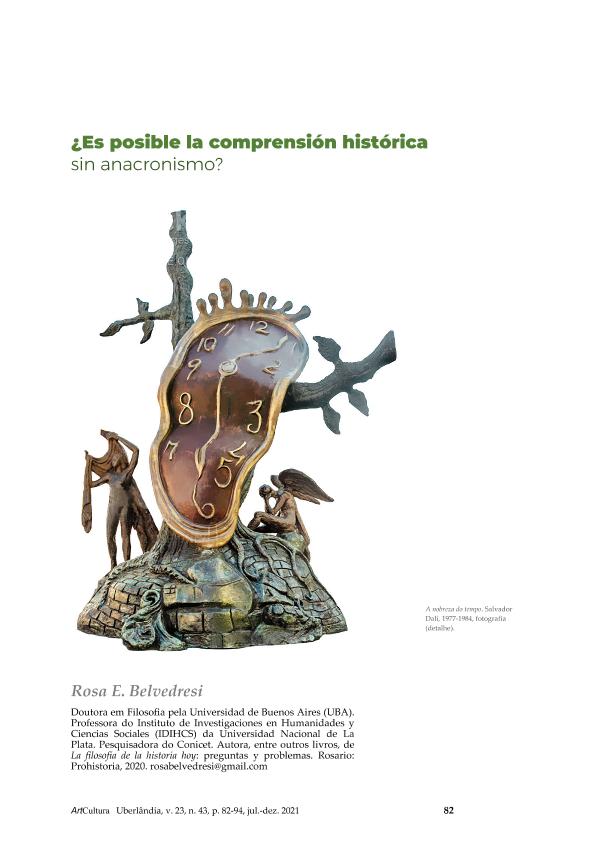Mostrar el registro sencillo del ítem
dc.contributor.author
Belvedresi, Rosa Elena

dc.date.available
2022-12-12T18:18:22Z
dc.date.issued
2021-12
dc.identifier.citation
Belvedresi, Rosa Elena; ¿Es posible la comprensión histórica sin anacronismo?; Universidade Federal de Uberlândia; ArtCultura; 23; 43; 12-2021; 82-94
dc.identifier.issn
1516-8603
dc.identifier.uri
http://hdl.handle.net/11336/180867
dc.description.abstract
El anacronismo se presenta como un obstáculo a la tarea de la historiadora o historiador que, en el afán por comprender el pasado, debe evitar las intromisiones de elementos que correspondan a una época distinta a aquella de su objeto de estudio, fundamentalmente, aquellos que provienen de su propio contexto. Problema largamente abordado por la teoría de la historia francesa así como por la filosofía y la historia del arte, el anacronismo da cuenta de un problema y a la vez de una condición necesaria. En este trabajo vamos a valorar el papel que juega el anacronismo en la comprensión histórica, para lo cual nos vamos a valer de dos ejemplos: las restituciones de objetos que realizan los museos en respuesta a reclamos de las comunidades originarias y la aplicación de las categorías de análisis que fueron creadas posteriormente a sucesos del pasado a los cuales se pretenden explicar, como es el caso del uso del concepto de “genocidio”. Finalizaremos argumentado a favor de la función que el anacronismo tiene para la comprensión del pasado y para iluminar el mundo presente.
dc.description.abstract
Anachronism is presented as an obstacle to the task of the historian who, in the effort to understand the past, must avoid interference of elements that correspond to a different time from that of her object of study, fundamentally, those that come from her own context. A problem long addressed by the French theory of history as well as by the philosophy and history of the art, anachronism accounts for a problem and at the same time a necessary condition. In this work we are going to assess the role played by anachronism in historical understanding, for which we are going to use two examples: the restitution of objects that museums make in response to claims of the indigenous communities and the application of the categories of analysis that were created later to events of the past to which they are intended to explain, as is the case of the use of the concept of “genocide”. We will finish arguing in favor of the function that anachronism has for the understanding of the past and to illuminate the present world.
dc.format
application/pdf
dc.language.iso
spa
dc.publisher
Universidade Federal de Uberlândia
dc.rights
info:eu-repo/semantics/openAccess
dc.rights.uri
https://creativecommons.org/licenses/by-nc-nd/2.5/ar/
dc.subject
ANACRONISMO
dc.subject
COMPRENSIÓN HISTÓRICA
dc.subject
RESTITUCIÓN
dc.subject
GENOCIDIO
dc.subject.classification
Historia

dc.subject.classification
Historia y Arqueología

dc.subject.classification
HUMANIDADES

dc.title
¿Es posible la comprensión histórica sin anacronismo?
dc.title
Is historical understanding possible without anachronism?
dc.type
info:eu-repo/semantics/article
dc.type
info:ar-repo/semantics/artículo
dc.type
info:eu-repo/semantics/publishedVersion
dc.date.updated
2022-10-04T18:02:35Z
dc.journal.volume
23
dc.journal.number
43
dc.journal.pagination
82-94
dc.journal.pais
Brasil

dc.journal.ciudad
Uberlandia
dc.description.fil
Fil: Belvedresi, Rosa Elena. Consejo Nacional de Investigaciones Científicas y Técnicas. Centro Científico Tecnológico Conicet - La Plata. Instituto de Investigaciones en Humanidades y Ciencias Sociales. Universidad Nacional de La Plata. Facultad de Humanidades y Ciencias de la Educación. Instituto de Investigaciones en Humanidades y Ciencias Sociales; Argentina
dc.journal.title
ArtCultura

dc.relation.alternativeid
info:eu-repo/semantics/altIdentifier/url/https://seer.ufu.br/index.php/artcultura/article/view/64084
dc.relation.alternativeid
info:eu-repo/semantics/altIdentifier/doi/https://doi.org/10.14393/artc-v23-n43-2021-64084
Archivos asociados
